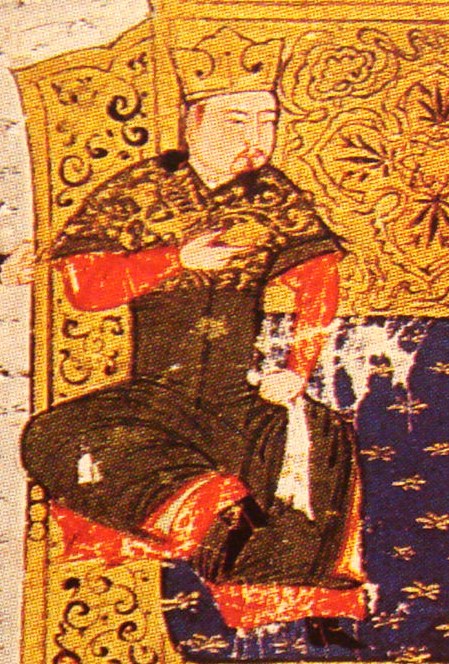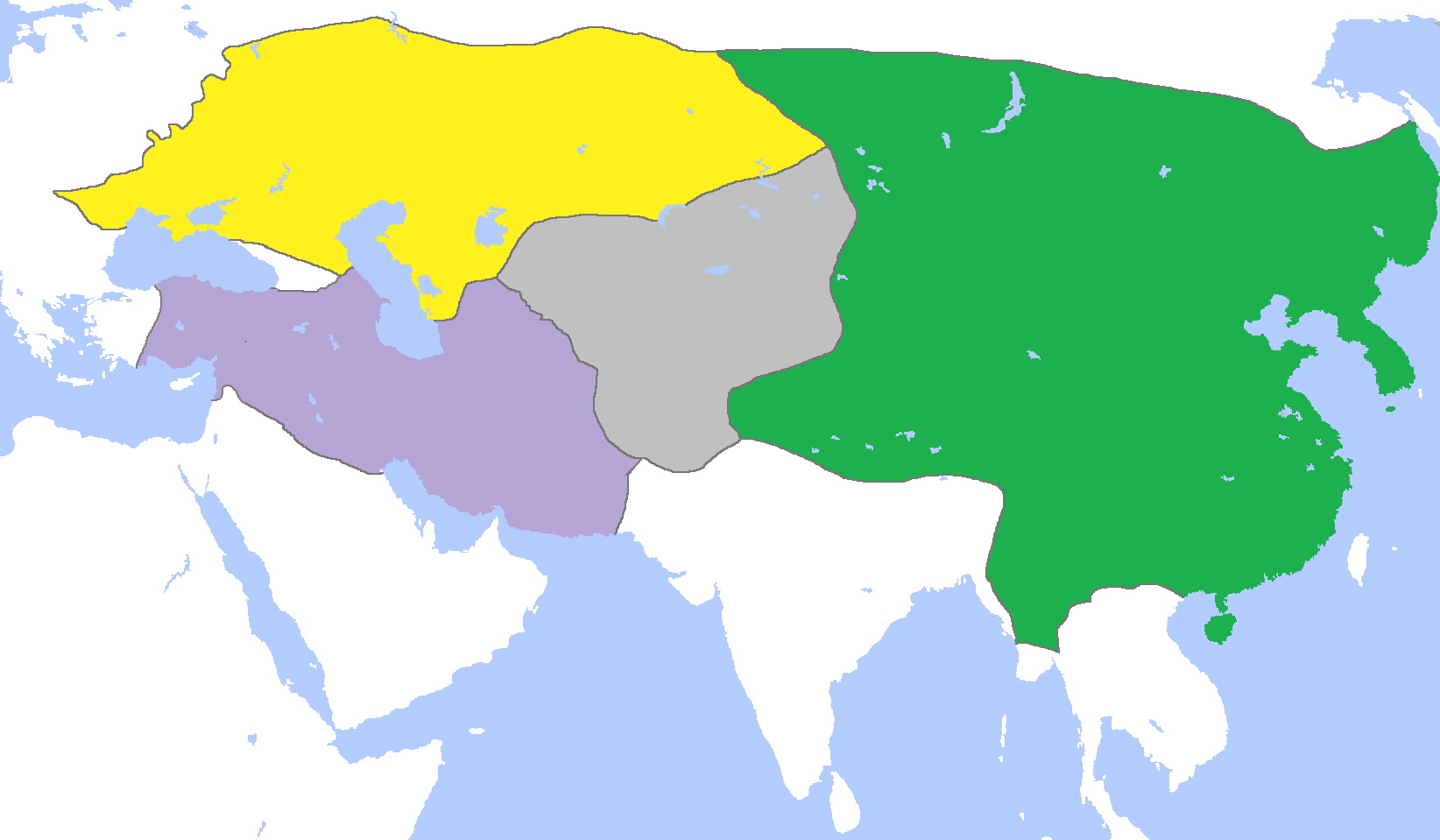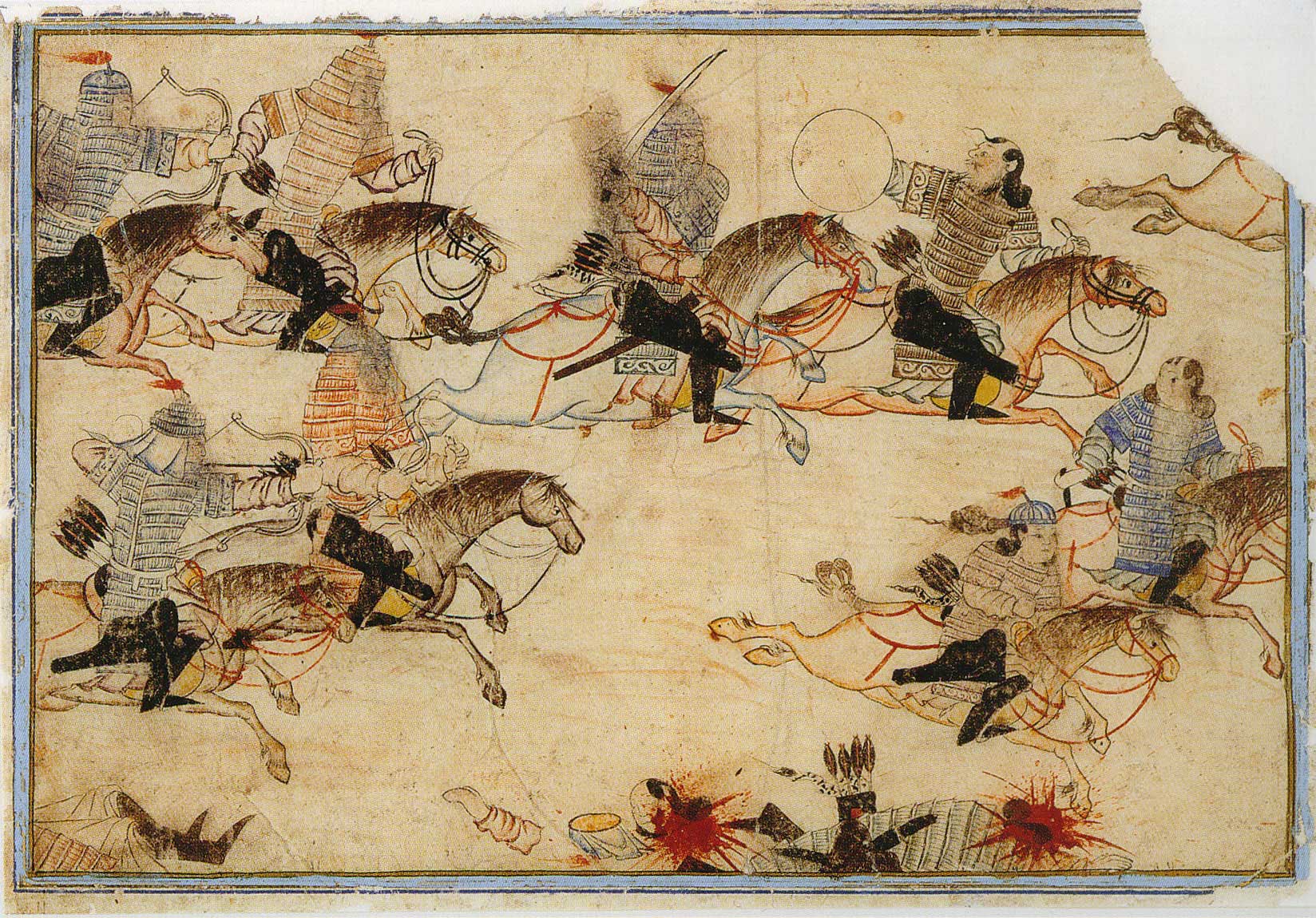|
Buyantu
Buyantu Khan ( Mongolian: Буянт хаан; Mongolian script: ; ), born Ayurbarwada (Mongolian: Аюурбарбад ; ), also known by the temple name Renzong (Emperor Renzong of Yuan ( Chinese: 元仁宗, April 9, 1285 – March 1, 1320), was the fourth emperor of the Yuan dynasty of China. Apart from Emperor of China, he is regarded as the eighth Great Khan of the Mongol Empire, although it was only nominal due to the division of the empire. His name means "blessed/good Khan" in the Mongolian language. His name "Ayurbarwada" was from a Sanskrit compound "Āyur-parvata" (), which means "the mountain of longevity", in contrast with Emperor Wuzong's name Qaišan (海山, "mountains and seas" in Chinese). Ayurbarwada was the first Yuan emperor who actively supported the adoption of Confucian principles into the administration system. The emperor, who was mentored by the Confucian academic Li Meng, succeeded peacefully to the throne and reversed his older brother Khayisan' ... [...More Info...] [...Related Items...] OR: [Wikipedia] [Google] [Baidu] |
Gegeen Khan
Gegeen Khan ( Mongolian: Гэгээн хаан; Mongol script: ; ''Shidebal Gegegen qaγan''; ; born Shidibala (; 碩德八剌), also known by the temple name Yingzong (Emperor Yingzong of Yuan, Chinese: 元英宗, February 22, 1302 – September 4, 1323), was an emperor of the Yuan dynasty of China. Apart from Emperor of China, he is regarded as the ninth Great Khan of the Mongol Empire, although it was only nominal due to the division of the empire. His born name “Shidi-bala” () in Sanskrit means "purity protection" and regnal name means "enlightened/bright khan" in the Mongolian language. Early in his short reign, the Khunggirat faction played a key role in the Yuan court. When his grandmother Dagi (Targi) and the grand councillor Temuder died in 1322, his opponents seemed to have triumphed. Despite the Emperor's aim to reform the government based on the Confucian principles, Temuder's faction linked up with the Alan guard and assassinated the emperor in 1323. This was the ... [...More Info...] [...Related Items...] OR: [Wikipedia] [Google] [Baidu] |
List Of Yuan Emperors
The following is a list of emperors of the Yuan dynasty (1271–1368). It also contains early rulers (khagans-emperors and regents) of the Mongol Empire posthumously honored by Kublai Khan as Yuan emperors. List of emperors Timeline ImageSize = width:1600 height:auto barincrement:15 PlotArea = top:10 bottom:30 right:120 left:20 AlignBars = early DateFormat = yyyy Period = from:1200 till:1390 TimeAxis = orientation:horizontal ScaleMajor = unit:year increment:10 start:1200 Colors = id:canvas value:rgb(0.97,0.97,0.97) id:ME value:rgb(1,0.6,0.2) id:YU value:rgb(0.2,0.8,0.8) id:NY value:rgb(1,0.2,0.6) Backgroundcolors = canvas:canvas BarData = barset:Rulers PlotData= width:5 align:left fontsize:S shift:(5,-4) anchor:till barset:Rulers from: 1206 till: 1227 color:ME text:"Genghis Khan (1206–1227 CE)" from: 1227 till: 1229 color:ME text:"Tolui (regent; 1227–1229 CE)" from: 1229 till: 1241 color:ME text:"Ögedei Khan (1 ... [...More Info...] [...Related Items...] OR: [Wikipedia] [Google] [Baidu] |
List Of Emperors Of The Yuan Dynasty
The following is a list of emperors of the Yuan dynasty (1271–1368). It also contains early rulers ( khagans-emperors and regents) of the Mongol Empire posthumously honored by Kublai Khan as Yuan emperors. List of emperors Timeline ImageSize = width:1600 height:auto barincrement:15 PlotArea = top:10 bottom:30 right:120 left:20 AlignBars = early DateFormat = yyyy Period = from:1200 till:1390 TimeAxis = orientation:horizontal ScaleMajor = unit:year increment:10 start:1200 Colors = id:canvas value:rgb(0.97,0.97,0.97) id:ME value:rgb(1,0.6,0.2) id:YU value:rgb(0.2,0.8,0.8) id:NY value:rgb(1,0.2,0.6) Backgroundcolors = canvas:canvas BarData = barset:Rulers PlotData= width:5 align:left fontsize:S shift:(5,-4) anchor:till barset:Rulers from: 1206 till: 1227 color:ME text:" Genghis Khan (1206–1227 CE)" from: 1227 till: 1229 color:ME text:"Tolui (regent; 1227–1229 CE)" from: 1229 till: 1241 color:ME text:"Ögedei Kha ... [...More Info...] [...Related Items...] OR: [Wikipedia] [Google] [Baidu] |
Külüg Khan
Külüg Khan ( Mongolian: Хүлэг; Mongolian script: ; ), born Khayishan (Mongolian: Хайсан ; , mn, Хайсан, meaning "wall"), also known by the temple name Wuzong (Emperor Wuzong of Yuan; ) (August 4, 1281 – January 27, 1311), Prince of Huaining (懷寧王) in 1304-1307, was an emperor of the Yuan dynasty of China. Apart from Emperor of China, he is regarded as the seventh Great Khan of the Mongol Empire, although it was only nominal due to the division of the empire. His name means "warrior Khan" or "fine horse Khan" in the Mongolian language. Early life He was the first son of Darmabala and Dagi of the influential Khunggirad clan, and the full brother of Ayurbarwada. He was sent to Mongolia to assume an army that defended the western front of the Yuan against Kaidu, ''de facto'' ruler of the Chagatai Khanate, and other princes in Central Asia under him. In 1289, Khayishan's force was nearly routed and the Kipchak commander, Tutugh, rescued him from cap ... [...More Info...] [...Related Items...] OR: [Wikipedia] [Google] [Baidu] |
Yuan Dynasty
The Yuan dynasty (), officially the Great Yuan (; xng, , , literally "Great Yuan State"), was a Mongol-led imperial dynasty of China and a successor state to the Mongol Empire after its division. It was established by Kublai, the fifth khagan-emperor of the Mongol Empire from the Borjigin clan, and lasted from 1271 to 1368. In orthodox Chinese historiography, the Yuan dynasty followed the Song dynasty and preceded the Ming dynasty. Although Genghis Khan had been enthroned with the Han-style title of Emperor in 1206 and the Mongol Empire had ruled territories including modern-day northern China for decades, it was not until 1271 that Kublai Khan officially proclaimed the dynasty in the traditional Han style, and the conquest was not complete until 1279 when the Southern Song dynasty was defeated in the Battle of Yamen. His realm was, by this point, isolated from the other Mongol-led khanates and controlled most of modern-day China and its surrounding areas, including ... [...More Info...] [...Related Items...] OR: [Wikipedia] [Google] [Baidu] |
Darmabala
Darmabala (also known as Dharmapala - , , , ) — was a Mongol prince, grandson of Kublai Khan, son of his Crown Prince Zhenjin. He was an ancestor of subsequent Yuan monarchs who came after Temür Khan and the Goryeo kings after Gongmin. Biography He was born in 1264 to Zhenjin and his wife Kökejin Khatun as the couple's second son. He was married to Dagi from Khongirad tribe around 1278. After Zhenjin's death on 5 January 1286, Darmabala came to be seen as a strong candidate for the position of heir-apparent by his grandfather and was appointed as commander of Mongol army in Jeju Island. He was described by Marco Polo as ' rickety'. He was dispatched to Huaizhou by Kublai in 1291, where he fell ill. He was treated in Khanbaliq until 1292 where he died. He was posthumously renamed Emperor Zhaosheng Yanxiao (昭聖衍孝皇帝) by Külüg Khan and was given the temple name Shunzong (顺宗). Family He had three sons and a daughter from two wives: # Dagi Khatun, posthumous ... [...More Info...] [...Related Items...] OR: [Wikipedia] [Google] [Baidu] |
Dagi Khatun
Dagi Khatun (, ; also known as Taji and Tagi) was a Mongol noblewoman, mother of Yuan emperors Külüg Khan and Ayurbawada Khan. Early life Her early life is unknown. She was from Khongirad clan, daughter of Kundu Temür, niece of Chabi and cousin of Nambui. She was married to Darmabala, son of Zhenjin, Crown Prince of Yuan around 1278. After Darmabala's death in 1292, she was forced to raise her sons alone, allying herself to Kökejin, widow of Zhenjin. She came into conflict with Empress Bulughan, widow of Temür Khan in 1306. Bulugan attempted to set up Muslim Ananda, son of Manggala as new khagan and exiled Dagi and his son Ayurbarwada to Huaizhou. Her alliance was supported by some senior officials of the Secretariat under Aqutai. Ananda was a popular prince who successfully protected the provinces of the Yuan against the Ögedeid and Chaghatayid armies and had a bulk of the imperial army under him in Anxi. But he lacked of military power in the imperial capital cit ... [...More Info...] [...Related Items...] OR: [Wikipedia] [Google] [Baidu] |
Emperor Of China
''Huangdi'' (), translated into English as Emperor, was the superlative title held by monarchs of China who ruled various imperial regimes in Chinese history. In traditional Chinese political theory, the emperor was considered the Son of Heaven and the autocrat of all under Heaven. Under the Han dynasty, Confucianism replaced Legalism as the official political theory and succession in most cases theoretically followed agnatic primogeniture. The lineage of emperors descended from a paternal family line constituted a dynasty. The absolute authority of the emperor came with a variety of governing duties and moral obligations; failure to uphold these was thought to remove the dynasty's Mandate of Heaven and to justify its overthrow. In practice, emperors sometimes avoided the strict rules of succession and dynasties' ostensible "failures" were detailed in official histories written by their successful replacements. The power of the emperor was also limited by the imperial burea ... [...More Info...] [...Related Items...] OR: [Wikipedia] [Google] [Baidu] |
Radnashiri
Empress Radnashiri or Aradnashiri (; Mongolian: Раднашири хатан) (died 1322) was an Empress consort of the Yuan dynasty, married to Ayurbarwada Buyantu Khan (Emperor Renzong). Life She was from the Khongirad tribe. It is not known when she met Ayurbarwada or his relation to any preceding empresses by blood. She gave birth to Shidibala on 22 February 1302. She became empress upon Ayurbarwada's elevation to throne in 1311. Her influence increased upon installment of Shidibala as the new crown prince but Dagi Dagi was an ancient Egyptian vizier during the reign of pharaoh Mentuhotep II of the Eleventh Dynasty. Dagi is mainly known from his tomb in Western Thebes ( TT103), which was once decorated with paintings and reliefs. From the reliefs only smal ...'s influence strictly limited hers. She was created Empress Dowager in 1320 by his son, now Emperor Gegeen Khan. However, she soon died in 1322, around the very time Dagi fell from power as well. She was posthumousl ... [...More Info...] [...Related Items...] OR: [Wikipedia] [Google] [Baidu] |
Imperial Examination
The imperial examination (; lit. "subject recommendation") refers to a civil-service examination system in Imperial China, administered for the purpose of selecting candidates for the state bureaucracy. The concept of choosing bureaucrats by merit rather than by birth started early in Chinese history, but using written examinations as a tool of selection started in earnest during the Sui dynasty (581–618) then into the Tang dynasty of 618–907. The system became dominant during the Song dynasty (960–1279) and lasted for almost a millennium until its abolition in the late Qing dynasty reforms in 1905. Aspects of the imperial examination still exist for entry into the civil service of contemporary China, in both the People's Republic of China (PRC) and the Republic of China (ROC). The exams served to ensure a common knowledge of writing, Chinese classics, and literary style among state officials. This common culture helped to unify the empire, and the ideal of achievement ... [...More Info...] [...Related Items...] OR: [Wikipedia] [Google] [Baidu] |
Mongol Empire
The Mongol Empire of the 13th and 14th centuries was the largest contiguous land empire in history. Originating in present-day Mongolia in East Asia, the Mongol Empire at its height stretched from the Sea of Japan to parts of Eastern Europe, extending northward into parts of the Arctic; eastward and southward into parts of the Indian subcontinent, attempted invasions of Southeast Asia and conquered the Iranian Plateau; and westward as far as the Levant and the Carpathian Mountains. The Mongol Empire emerged from the unification of several nomadic tribes in the Mongol homeland under the leadership of Temüjin, known by the more famous title of Genghis Khan (–1227), whom a council proclaimed as the ruler of all Mongols in 1206. The empire grew rapidly under his rule and that of his descendants, who sent out invading armies in every direction. The vast transcontinental empire connected the East with the West, and the Pacific to the Mediterranean, in an enforced ''Pax Mongol ... [...More Info...] [...Related Items...] OR: [Wikipedia] [Google] [Baidu] |
Division Of The Mongol Empire
The division of the Mongol Empire began when Möngke Khan died in 1259 in the siege of Diaoyu Castle with no declared successor, precipitating infighting between members of the Tolui family line for the title of khagan that escalated into the Toluid Civil War. This civil war, along with the Berke–Hulagu war and the subsequent Kaidu–Kublai war, greatly weakened the authority of the great khan over the entirety of the Mongol Empire, and the empire fractured into four khanates: the Golden Horde in Eastern Europe, the Chagatai Khanate in Central Asia, the Ilkhanate in Southwest Asia, and the Yuan dynasty in East Asia based in modern-day Beijing – although the Yuan emperors held the nominal title of khagan of the empire. The four divisions each pursued their own interests and objectives and fell at different times. Dispute over succession Möngke Khan's brother Hulagu Khan broke off his successful military advance into Syria, withdrawing the bulk of his forces to Mughan and ... [...More Info...] [...Related Items...] OR: [Wikipedia] [Google] [Baidu] |
.jpg)








